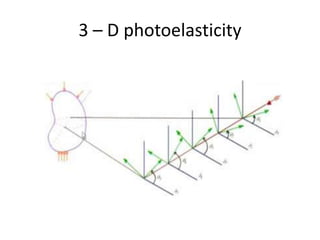
3 d potostress
- 1. 3 – D photoelasticity
- 3. Molecular structure in an Epoxy
- 4. 3 – D photoelasticity Disc under diametric compression
- 6. 3 – D photoelasticity Effect of Machining in stress freezed model
- 7. 3 – D photoelasticity
- 8. Model fabrication and Loading • 3-D model of the joint comprising a ball insert , base ring bush base ring block are fabricated by using Epoxy resin (ArlditeCY-230) and hardener (HY-951). • The fabricated parts are assembled and loaded and stress frozen.
- 9. Model fabrication and stress freezing • A suitable force is applied using dead weight along the ball centre. • After stress freezing, the slices are cut from the stress frozen model along the loading plane, where the stress is maximum.
- 10. Stress Freezing
- 11. Central Slice
- 13. Principle of optical equivalence • The retarder introduces the retardation equivalent to the one introduced by 3-D model. • The azimuth of the exit light ellipse may not be the same as that for for a 3-D model.the necessary correction is done by the rotater. • The parameters representing the retarder and rotater are the experimental parameters to be determined in integrated photoelasticity.
- 15. Principle of optical equivalence • The retardation is termed as characteristic retardation and denoted by 2∆ • The orientation of the retarder is termed as the primary characteristic direction denoted by the symbol θ. • An idealised optical element, which simply rotates the azimuth of the light ellipse is specified by the angular rotation γ
- 16. Principle of optical equivalence • The angle γ is termed as characteristic rotation. • the summary is as follows: • Once the retardation and rotation is known at the point of interest, jones matrix can be constructed. • Suppose take problem in which stress distribution is known along the light path.
- 17. Integrated photoelasticity • Then analytically jones matrix can be written for each of the planes and multiply of them. • This gives the final jones matrix and compare this with the jones matrix which is written from experimental values and find the parameters related to stress distribution.
- 18. Integrated photoelasticity • So we need to assume stress distribution field reasonably well with several coefficients, and find the necessary number of equations equal to coefficients. • Hence we need multiple optical paths and multiple collection of charecteristic parameters so it becomes mathematically intensive.